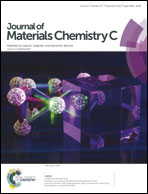New building blocks for π-conjugated polymer semiconductors for organic thin film transistors and photovoltaics
Abstract
Rapidly growing research interest in the field of printed electronics, especially polymer-based organic thin film transistors (OTFTs) and organic photovoltaics (OPVs), stems from the dramatically improved performance of these devices, which become competitive to the amorphous silicon-based counterparts. The performance enhancement of polymer OTFTs and OPVs is largely attributed to the progress made in the development of polymer semiconductor materials. Therefore exploration of new building blocks for developing high-performance polymer semiconductors has been an area of extensive research. This article provides an overview of new building blocks including 21 electron acceptors and 20 electron donors, which were developed over the past three years for constructing π-conjugated polymers, particularly donor–acceptor (D–A) type polymers. Polymers containing these building blocks have shown very promising performance as active semiconductors in OTFTs and OPVs. Rationales for the structural design and the device performance of the polymers based on these new building blocks are discussed.


 Please wait while we load your content...
Please wait while we load your content...